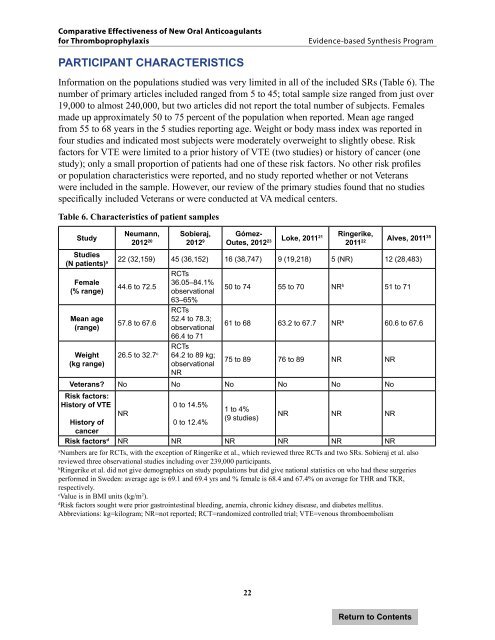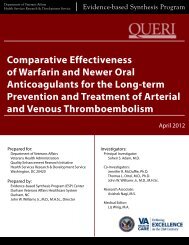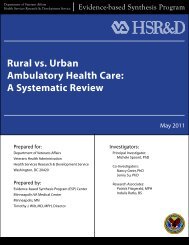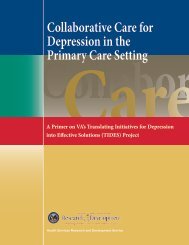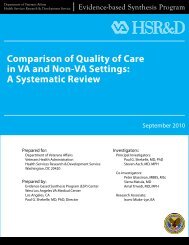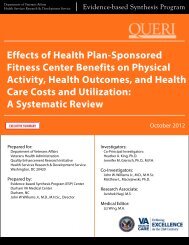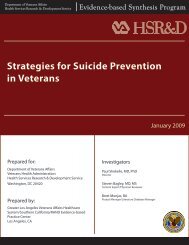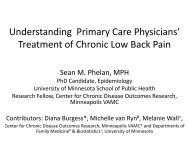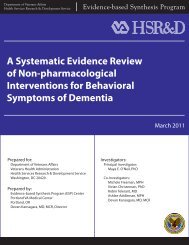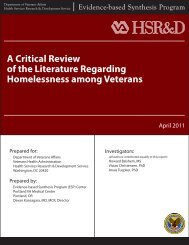Comparative Effectiveness of New Oral Anticoagulants for ...
Comparative Effectiveness of New Oral Anticoagulants for ...
Comparative Effectiveness of New Oral Anticoagulants for ...
You also want an ePaper? Increase the reach of your titles
YUMPU automatically turns print PDFs into web optimized ePapers that Google loves.
<strong>Comparative</strong> <strong>Effectiveness</strong> <strong>of</strong> <strong>New</strong> <strong>Oral</strong> <strong>Anticoagulants</strong><br />
<strong>for</strong> Thromboprophylaxis<br />
Evidence-based Synthesis Program<br />
PARTICIPANT CHARACTERISTICS<br />
In<strong>for</strong>mation on the populations studied was very limited in all <strong>of</strong> the included SRs (Table 6). The<br />
number <strong>of</strong> primary articles included ranged from 5 to 45; total sample size ranged from just over<br />
19,000 to almost 240,000, but two articles did not report the total number <strong>of</strong> subjects. Females<br />
made up approximately 50 to 75 percent <strong>of</strong> the population when reported. Mean age ranged<br />
from 55 to 68 years in the 5 studies reporting age. Weight or body mass index was reported in<br />
four studies and indicated most subjects were moderately overweight to slightly obese. Risk<br />
factors <strong>for</strong> VTE were limited to a prior history <strong>of</strong> VTE (two studies) or history <strong>of</strong> cancer (one<br />
study); only a small proportion <strong>of</strong> patients had one <strong>of</strong> these risk factors. No other risk pr<strong>of</strong>iles<br />
or population characteristics were reported, and no study reported whether or not Veterans<br />
were included in the sample. However, our review <strong>of</strong> the primary studies found that no studies<br />
specifically included Veterans or were conducted at VA medical centers.<br />
Table 6. Characteristics <strong>of</strong> patient samples<br />
Neumann, Sobieraj, Gómez-<br />
Ringerike,<br />
Study<br />
Loke, 2011<br />
2012 20 2012 9 Outes, 2012 21 Alves, 2011 23 2011 35<br />
22<br />
Studies<br />
22 (32,159) 45 (36,152) 16 (38,747) 9 (19,218) 5 (NR) 12 (28,483)<br />
(N patients) a<br />
Female<br />
(% range)<br />
Mean age<br />
(range)<br />
Weight<br />
(kg range)<br />
RCTs<br />
36.05–84.1%<br />
44.6 to 72.5<br />
observational<br />
63–65%<br />
RCTs<br />
52.4 to 78.3;<br />
57.8 to 67.6<br />
observational<br />
66.4 to 71<br />
RCTs<br />
26.5 to 32.7 c 64.2 to 89 kg;<br />
observational<br />
NR<br />
50 to 74 55 to 70 NR b 51 to 71<br />
61 to 68 63.2 to 67.7 NR b 60.6 to 67.6<br />
75 to 89 76 to 89 NR NR<br />
Veterans? No No No No No No<br />
Risk factors:<br />
History <strong>of</strong> VTE<br />
0 to 14.5%<br />
1 to 4%<br />
NR<br />
(9 studies)<br />
History <strong>of</strong><br />
0 to 12.4%<br />
NR NR NR<br />
cancer<br />
Risk factors d NR NR NR NR NR NR<br />
a<br />
Numbers are <strong>for</strong> RCTs, with the exception <strong>of</strong> Ringerike et al., which reviewed three RCTs and two SRs. Sobieraj et al. also <br />
reviewed three observational studies including over 239,000 participants.<br />
b<br />
Ringerike et al. did not give demographics on study populations but did give national statistics on who had these surgeries <br />
per<strong>for</strong>med in Sweden: average age is 69.1 and 69.4 yrs and % female is 68.4 and 67.4% on average <strong>for</strong> THR and TKR, <br />
respectively.<br />
c<br />
Value is in BMI units (kg/m 2 ).<br />
d<br />
Risk factors sought were prior gastrointestinal bleeding, anemia, chronic kidney disease, and diabetes mellitus. <br />
Abbreviations: kg=kilogram; NR=not reported; RCT=randomized controlled trial; VTE=venous thromboembolism<br />
22


